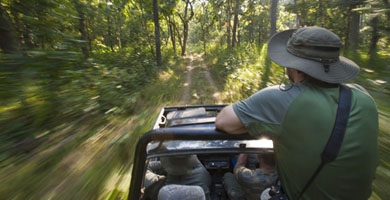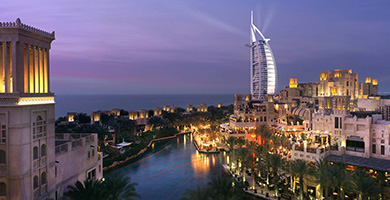A Passage Through India
 India is one of those destinations that stir the soul, heighten the senses, and stimulate the intellect. A vast country encompassing multiple cultures, religions and languages (21 recognized and over a thousand more dialects), India could never be fully explored in a lifetime, let alone one trip, so don’t try to overachieve. Just breathe deeply and follow your instinct. Be prepared for a trip that will be one of the most challenging you will ever undertake, and certainly one of the most rewarding as well.
India is one of those destinations that stir the soul, heighten the senses, and stimulate the intellect. A vast country encompassing multiple cultures, religions and languages (21 recognized and over a thousand more dialects), India could never be fully explored in a lifetime, let alone one trip, so don’t try to overachieve. Just breathe deeply and follow your instinct. Be prepared for a trip that will be one of the most challenging you will ever undertake, and certainly one of the most rewarding as well.
To get you started, we’ve listed a few suggested destinations both well-traveled and off-the-beaten path. They represent different aspects of the Indian Subcontinent: kinetic urban centers, evocative architecture, spiritual centers, untamed nature, and in some cases, a combination of several of these attributes. This itinerary also focuses on one region, Madhya Pradesh in India’s center─a good strategy to use when traveling across a country spanning over one million square miles.
Delhi/New Delhi
 One of the most important cities in India for thousands of years, Delhi and its scion, New Delhi, located just south and the country’s capital, remain important centers for the country’s culture and economy. Convenient for catching trains, planes, and buses to just about anywhere in the Subcontinent, Delhi is also a fascinating destination in its own right, filled with museums, monuments, and layers of history, complemented by a wide array of hotel choices, restaurants, and nightlife. A few of the more noteworthy locations worth exploring include the excellent National Museum featuring India’s rich legacy; the Old City’s Red Fort; spiritual centers like the modernist Baha’i Lotus Temple and Akshardham Temple, the largest Hindu complex in the world; and the three-hundred-year-old Chandni Chowk market, a bargain-hunter’s paradise.
One of the most important cities in India for thousands of years, Delhi and its scion, New Delhi, located just south and the country’s capital, remain important centers for the country’s culture and economy. Convenient for catching trains, planes, and buses to just about anywhere in the Subcontinent, Delhi is also a fascinating destination in its own right, filled with museums, monuments, and layers of history, complemented by a wide array of hotel choices, restaurants, and nightlife. A few of the more noteworthy locations worth exploring include the excellent National Museum featuring India’s rich legacy; the Old City’s Red Fort; spiritual centers like the modernist Baha’i Lotus Temple and Akshardham Temple, the largest Hindu complex in the world; and the three-hundred-year-old Chandni Chowk market, a bargain-hunter’s paradise.
Varanasi
The Hindu holy city of Varanasi (known previously as Benares) sits at the very center of India’s sacred geography, like the hub of a wheel whose spokes extend north to the Himalayas, east to Puri, south to Kanyakumari and west to Dwarka. Continuously inhabited since the 6th Century BC, this ancient city is defined by its wealth of temples and riparian lifeblood, the Ganges. Here at the river’s edge, ghats or public landings, serve as a hub of activity for Indians of all walks of life. Coming alive at daybreak, these ghats are lyrical spots to watch life unfold as it has for centuries, first with locals and pilgrims coming to the water’s edge for ritual baths at dawn, then the washing down of water buffalo in the afternoon, followed by raucous aartis, or devotional services accompanied by clanging bells and flickering urns that bathe the ghats in sound and color before ending another day. The city itself is a warren of serpentine lanes filled with bicycles, scooters, school kids, cows (and cow dung of course), and touts hustling every trinket and tour imaginable. Dive in and explore! The many notable temples and sacred spots also merit a visit, such as Adi Vishweshwara, Vishwanatha or Golden Temple and Manikrnika Kund. Special tours can be arranged to help you navigate both the mind-boggling alleys and strict etiquette necessary to visit these special places.
Khajuraho
Your best route to the mystical temple complexes of Khajuraho is the one hour plane flight from Varanasi, as there are no direct rail or bus lines here. With graceful spires staggered up to ten stories high, some say the temples are meant to echo the Himalayas, abode of the Gods. What is explicitly clear, however, is the  temples display of incredible symmetry and unrepentant sensuality. Built by the Chandela dynasty a thousand years ago, the temples─especially on the north and south-facing walls─feature intricatel-carved figures of gods and goddesses, along with everyday men and women, twining in sometimes seemingly impossible erotic embraces. The Western Group of Temples, including Lakshmana and Kandariya Mahadeva (once a Shiva temple), are the most impressive, standing like giant chess pieces on a flat, verdant plain. Scenes of daily life, battles, lovers, animals, and ornately-carved arches and garlands rendered in sandstone on these and other temples scattered throughout the area provide an eternally evocative view into India’s rich and complex spiritual and dynastic history.
temples display of incredible symmetry and unrepentant sensuality. Built by the Chandela dynasty a thousand years ago, the temples─especially on the north and south-facing walls─feature intricatel-carved figures of gods and goddesses, along with everyday men and women, twining in sometimes seemingly impossible erotic embraces. The Western Group of Temples, including Lakshmana and Kandariya Mahadeva (once a Shiva temple), are the most impressive, standing like giant chess pieces on a flat, verdant plain. Scenes of daily life, battles, lovers, animals, and ornately-carved arches and garlands rendered in sandstone on these and other temples scattered throughout the area provide an eternally evocative view into India’s rich and complex spiritual and dynastic history.
Orccha
Appearing almost as a mirage through the mists of time (it’s actually a yellow, sunny haze caused by diesel fumes and the smoke of villagers burning fields to clear them), the slowly decaying palaces and temples of Orccha still speak fluently of past glories. Located in Madhya Pradesh and an accessible five-hour drive from Khajuraho, Orccha, which means “hidden place,” was once the home of wealthy Hindu princes loyal to powerful Moghul invaders. Here, courtly decadence was refined to a high art, with a favorite courtesan’s private villa still resplendent centuries after lavish performances and royal trysts with the raja have been forgotten.
Though almost 500 years old, the architecture remains striking─a textbook example of the fusion of Islamic and Hindu design resulting from the arrival of the Moghuls. One of the palaces has been converted to a hotel, while the village at the approach before the River Betwa has interesting stalls, good restaurants, and several guesthouses and hotels.
Panna National Park
Don’t visit India without taking time out to breath in the fresh air and unspoiled vistas of a national park or preserve. Panna, one of India’s largest, can be visited as a day-trip from Khajaraho. Set along the scenic River Ken, the park is home to several species of antelope and deer, including elk-sized sambar as well as both species of Indian crocodiles. The most prized sighting here, however, are tigers, which still roam this former royal hunting preserve. (*Editors note: not only did I spot an adult Bengal tiger, I followed my guides at a full sprint back to our Jeep after another let out a thunderous roar from about 100 yards away while we hiked).
 Agra
Agra
Haze. Fumes. Frenzy. Traffic. And then there is the Taj Mahal. Splendid beyond all vapid adjectives, it simply must be seen. Commissioned by the Moghul sultan Shah Jahan, 20,000 workers toiled for over 20 years, four centuries ago to build this magnificent testament to love, faith, and power. Beyond the sublime symmetry and impressive scale, intricate carvings and inlaid precious stones which detail the structure add yet another layer of astonishing accomplishment to a true wonder of the world. Heading westward along the Yamuna river, Agra Fort is another excellent reason to visit. A symbol of the Moghul’s power over the region, its red sandstone battlements, interior courtyards, and royal pavilions summon the ghosts of times past. Those looking to take a piece of India home with them won’t be disappointed either. Look for inlaid marble tables, vases, beautiful Taj-inspired rugs, and leather goods in nearby workshops and boutiques.
For more images of India, check out wandermelon’s India slideshow.
Getting There
Flights: Some of the airlines flying to India include Delta, KLM, Thai Airways, Jet Airways and Air India.
Guides: Even experienced travelers find India a challenging trip. Mercury Tours, with offices in the US, can arrange all manner of transportation, including plane, bus and train tickets as well as secure private drivers to more remote areas. Representatives and guides, whether needed to traverse a wildlife preserve or the Agra train station, are prompt and courteous.
Latest posts by Eric Hiss
- Water Warriors Hit The Beach In SOUTHERN CALIFORNIA - September 4, 2015
- BORA BORA'S Ultimate Beach Party - November 17, 2014
- Surf in Style in LAGUNA NIGUEL - June 26, 2014




Westend Holiday Home, T-60, Bhogal Road, Jangpura, New Delhi. Near Nizamuddin Railway Station, whhdelhi@gmail.com.Nice food, nice staff ovrleal a nice and decent place to stay (as per my experience)